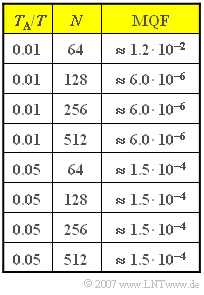Exercise 5.3Z: Zero-Padding
We consider the DFT of a rectangular pulse $x(t)$ of height $A =1$ and duration $T$. Thus the spectral function $X(f)$ has a $\sin(f)/f$–shaped course.
For this special case the influence of the DFT parameter $N$ is to be analyzed, whereby the interpolation point distance in the time domain should always be $T_{\rm A} = 0.01T$ or $T_{\rm A} = 0.05T$.
The resulting values for the "mean square error" $\rm (MSE)$ of the grid values in the frequency domain are given opposite for different values of $N$. Here, we use instead of $\rm MSE$ the designation $\rm MQF$ ⇒ (German: "Mittlerer Quadratischer Fehler"):
- $${\rm MQF} = \frac{1}{N}\cdot \sum_{\mu = 0 }^{N-1} \left|X(\mu \cdot f_{\rm A})-\frac{D(\mu)}{f_{\rm A}}\right|^2 \hspace{0.05cm}.$$
Thus, for $T_{\rm A}/T = 0.01$ , $101$ of the DFT coefficients $d(ν)$ are always different from zero.
- Of these, $99$ have the value $1$ and the two marginal coefficients are each equal to $0.5$.
- If $N$ is increased, the DFT coefficient field is filled with zeros.
- This is then referred to as $\text{zero padding}$.
Hints:
- This task belongs to the chapter Possible errors when using DFT.
- The theory for this chapter is summarised in the (German language) learning video
Fehlermöglichkeiten bei Anwendung der DFT ⇒ "Possible errors when using DFT".
Questions
Solution
- Already with $N = 128$, $T_{\rm P} = 1.28 \cdot T$, i.e. larger than the width of the rectangle.
- Thus the truncation error plays no role at all here.
- The $\rm MQF$ value is determined solely by the aliasing error.
- The numerical values clearly confirm that $\rm MQF$ is (almost) independent of $N$.
(2) From $T_{\rm A}/T = 0.01$ follows $f_{\rm P} \cdot T = 100$.
- The supporting values of $X(f)$ thus lie in the range $–50 ≤ f \cdot T < +50$.
- For the distance between two samples in the frequency range, $f_{\rm A} = f_{\rm P}/N$ applies. This gives the following results:
- $N = 128$: $f_{\rm A} \cdot T \; \underline{\approx 0.780}$,
- $N = 512$: $f_{\rm A} \cdot T \; \underline{\approx 0.195}$.
(3) The first statement is correct:
- For $N = 128$ , the product is $\text{MQF} \cdot f_{\rm A} \approx 4.7 \cdot 10^{-6}/T$. For $N = 512$ , the product is smaller by a factor of about $4$ .
- This means that „zero padding” does not achieve greater DFT accuracy, but a finer "resolution" of the frequency range.
- The product $\text{MQF} \cdot f_{\rm A}$ takes this fact into account; it should always be as small as possible.
(4) Proposed solutions 1 and 4 are correct:
- Because of $T_{\rm A} \cdot f_{\rm A} \cdot N = 1$ , a constant $N$ always results in a smaller $f_{\rm A}$ value when $T_{\rm A}$ is increased.
- From the table on the information page, one can see that the mean square error $\rm (MQF)$ is significantly increased $($by a factor of about $400)$.
- The effect is due to the aliasing error, since the transition from $T_{\rm A}/T = 0.01$ auf $T_{\rm A}/T = 0.05$ reduces the frequency period by a factor of $5$ .
- The truncation error, on the other hand, continues to play no role with the rectangular pulse as long as $T_{\rm P} = N \cdot T_{\rm A}$ is greater than the pulse duration $T$.
(5) All statements are true:
- With the parameter values $N = 64$ and $T_{\rm A}/T = 0.01$ , an extremely large truncation error occurs.
- All time coefficients are $1$, so the DFT incorrectly interprets a DC signal instead of the rectangular function.
